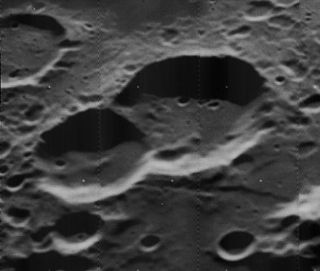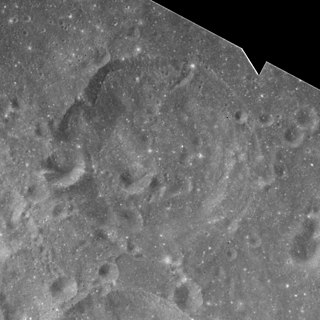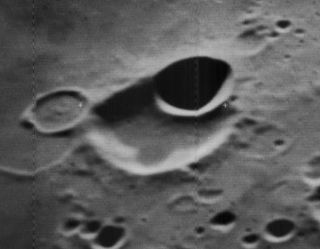 Oblique Lunar Orbiter 5 image of McNair (left) and Jarvis (right) | |
| Coordinates | 34°54′S148°54′W / 34.9°S 148.9°W Coordinates: 34°54′S148°54′W / 34.9°S 148.9°W |
|---|---|
| Diameter | 38 km |
| Depth | Unknown |
| Colongitude | 149° at sunrise |
| Eponym | Gregory Jarvis |
Jarvis is a crater that lies on the far side of the Moon. It is located within the walled plain Apollo, and lies in the eastern half of this basin within the interior ring.

An impact crater is an approximately circular depression in the surface of a planet, moon, or other solid body in the Solar System or elsewhere, formed by the hypervelocity impact of a smaller body. In contrast to volcanic craters, which result from explosion or internal collapse, impact craters typically have raised rims and floors that are lower in elevation than the surrounding terrain. Impact craters range from small, simple, bowl-shaped depressions to large, complex, multi-ringed impact basins. Meteor Crater is a well-known example of a small impact crater on Earth.

Earth's Moon is an astronomical body that orbits the planet and acts as its only permanent natural satellite. It is the fifth-largest satellite in the Solar System, and the largest among planetary satellites relative to the size of the planet that it orbits. The Moon is, after Jupiter's satellite Io, the second-densest satellite in the Solar System among those whose densities are known.

Apollo is an enormous impact crater located in the southern hemisphere on the far side of the Moon. This formation dwarfs the large crater Oppenheimer that is located next to the western rim. The crater Barringer lies across the northern wall. To the southeast is the crater Anders, and Kleymenov is just to the east of the rim.
Jarvis has a low, somewhat worn outer rim that is generally circular. There is a wide break in the south-southeastern portion of the rim where is it partly overlain by the crater McNair. The latter is younger than Jarvis, since its rim still survives where it intersects the interior of Jarvis. The interior of the crater is otherwise undistinguished, being marked only by tiny craters and some low ridges along the ramparts of McNair.

McNair is a small lunar impact crater on the far side of the Moon. It lies within the double-ringed Apollo basin, inside the eastern part of the interior ring. It has partly merged with the crater Jarvis, and the two share a common rim. To the south of McNair lies Borman.
The crater name was approved by the IAU in 1988 in honor of Gregory Jarvis, killed in the Space Shuttle Challenger disaster on January 28, 1986. [1] The crater was formerly designated Borman Z, a satellite crater of Borman.

The International Astronomical Union is an international association of professional astronomers, at the PhD level and beyond, active in professional research and education in astronomy. Among other activities, it acts as the internationally recognized authority for assigning designations and names to celestial bodies and any surface features on them.

Gregory Bruce Jarvis was an American engineer who died during the destruction of the Space Shuttle Challenger on mission STS-51-L, where he was serving as payload specialist for Hughes Aircraft.

On January 28, 1986, the NASA shuttle orbiter undertaking mission STS-51-L and the tenth flight of Space ShuttleChallenger (OV-99) broke apart 73 seconds into its flight, killing all seven crew members: five NASA astronauts, one payload specialist, and a civilian school teacher. The spacecraft disintegrated over the Atlantic Ocean, off the coast of Cape Canaveral, Florida, at 11:39 a.m. EST. The disintegration of the vehicle began after a joint in its right solid rocket booster (SRB) failed at liftoff. The failure was caused by the failure of O-ring seals used in the joint that were not designed to handle the unusually cold conditions that existed at this launch. The seals' failure caused a breach in the SRB joint, allowing pressurized burning gas from within the solid rocket motor to reach the outside and impinge upon the adjacent SRB aft field joint attachment hardware and external fuel tank. This led to the separation of the right-hand SRB's aft field joint attachment and the structural failure of the external tank. Aerodynamic forces broke up the orbiter.




















